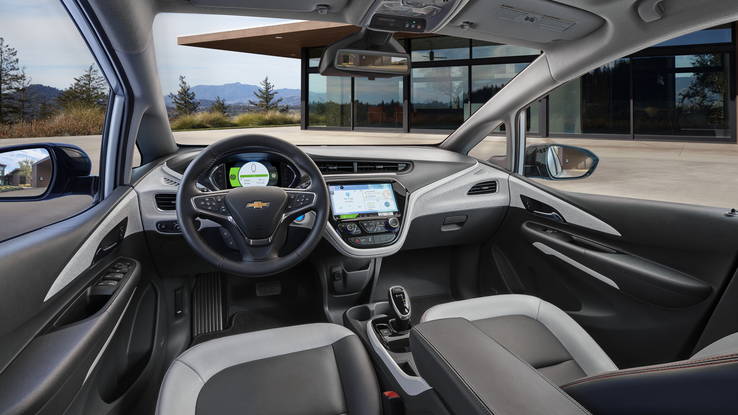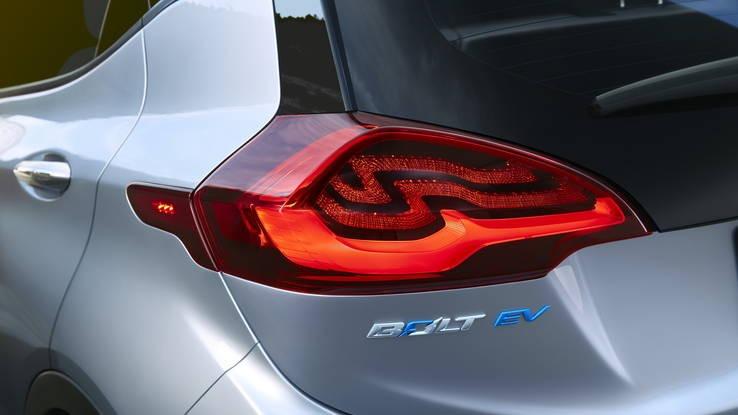It was only a few laps around a parking lot, but they were a very promising few laps
What is it?
The 2017 Chevrolet Bolt is GM’s first all-electric car since the EV1. It sits on its own new platform made specifically for an EV. Other EVs such as Chevy’s Spark EV are on what GM calls “legacy platforms,” existing gasoline-powered vehicles converted, for better or worse, to electric propulsion. With its own architecture, the Bolt is packaged far more efficiently and performs far better than the Spark EV. It has a roomy 94.4 cubic feet of passenger volume inside with another 16.9 cubic feet of cargo room behind the upright rear seats. The battery pack sits flat under the floor. Detailed specs are coming next week at Detroit, but with a claimed 200-mile range, we’d guess the battery size is more than 60 kWh … but that’s just a guess.
The Bolt is also packed with modern connectivity electronics. As we noted yesterday at the Bolt’s CES reveal, as you approach the car it senses and automatically connects to your smartphone, GM claims. OnStar 4G LTE turns the Bolt into its own WiFi hotspot. A 10.2-inch MyLink color touchscreen display sits on the instrument panel. The outside rear-view camera is piped into the inside rear-view mirror for a wider, better driver’s view behind (a little spray jet keeps it clear of road grime). A new MyChevrolet Mobile App allows for remote vehicle starting, cabin warmup and displays vehicle charge status. The NAV system can even pick out routes best for electric vehicles to maximize battery range. Bolt owners can also compete amongst themselves for best range via a coming “gamification” feature.

2017 Chevrolet Bolt EV
What’s it like to drive?
If you’re used to more practical and efficient EVs about this size, like, say, the Spark EV or the Mitsubishi iMiEV or even the Leaf, you will be pleasantly surprised by the Bolt’s responsiveness. Off the line it, ahem, bolts. We heard one GM staffer say 60 mph arrives in “under seven seconds.” That is competitive with moderately well-performing cars of a similar size. We launched it over and over in our four or five laps of an autocross-style course in a parking lot across the street from CES and were always happy to feel the surge of acceleration.
The regenerative brakes came on smoothly and seamlessly, too. There wasn’t a lot of feel through the brake pedal, so you’re not going to get the same autocross response you’d want there, but neither is the pedal made of wood, with no feedback at all. We couldn’t feel the difference when it switched from regen to hydraulic braking, assuming it went into hydraulic braking on our drive. It certainly should have, as we stomped on the brakes pretty hard.
Coming out of corners we were no less aggressive. The inside front tire would chirp, a little surprising since we figured they’d have worked that out through the electronic throttle. The throttle itself has a sport button, but it changes only the pedal response and not the amount of juice going to the motor.
Body roll was likewise well-controlled for such a tall car. Transitioning from one corner to the next, the Bolt stayed composed the whole way.
Granted, no one is going to autocross these things, but there we were on what was essentially an autocross course, so we just had to hammer it.
For more typical urban and suburban driving, we could say the ride was quiet, and the Bolt eases out of its parking space and gets underway with smooth decorum. You can sneak in and out of your parking garage late at night undetected. This would be a fine car for ninjas, though GM expects the average buyer to be a professional urban city dweller.

2017 Chevrolet Bolt EV
Do I want it?
The price is going to start at about $ 30,000, after government rebates, so it’s a little higher than a base Leaf, for instance. But with 94.4 cubic feet of passenger volume, it’s a little larger than the Leaf. And maybe a bit more fun to drive. Drive ’em all and make your decision, but as far as EVs go, the Bolt seems to be a very solid entry in the class.




























